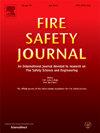Smoke movement and stratification of tunnel fires under coupled effects of rainfall and ventilation
IF 3.4
3区 工程技术
Q2 ENGINEERING, CIVIL
引用次数: 0
Abstract
This study investigates the smoke movement and stratification characteristics of tunnel fires under coupled effects of rainfall and ventilation through a series of reduced-scale tests. Results show that the smoke movement is affected by both ventilation and rainfall-induced airflow. The smoke tends to move downstream of the dominant airflow. As the increase in ventilation velocity, the height of the downstream smoke layer decreases. Conversely, as the rainfall intensity increases, the height of the upstream smoke layer decreases. Forced shear airflow consistently disrupts the smoke stratification downstream of the flow, whether induced by ventilation or rainfall. Although strong ventilation is capable of controlling smoke downstream, it may destroy the downstream smoke stratification. Compared to critical velocity, the confinement velocity is more suitable for tunnel smoke control as it maintains the stability of downstream smoke and thus can be applied in the early stage of fires. The confinement velocity is found to be 0.73 times the critical velocity. A model of the confinement velocity under the effect of rainfall is established. Findings are helpful in emergency rescue and evacuation of tunnel fires under rainfall conditions.
降雨与通风耦合作用下隧道火灾烟气运动与分层
本文通过一系列小尺度试验,研究了降雨和通风耦合作用下隧道火灾的烟气运动和分层特征。结果表明,烟气运动受通风和降雨气流的双重影响。烟雾趋向于顺着主导气流向下游移动。随着通风速度的增加,下游烟层高度降低。相反,随着降雨强度的增大,上游烟层高度减小。无论是由通风还是降雨引起的,强制剪切气流始终破坏气流下游的烟雾分层。强通风虽然能够控制下游的烟雾,但可能破坏下游的烟雾分层。与临界速度相比,约束速度更适合于隧道烟雾控制,因为它保持了下游烟雾的稳定性,因此可以在火灾的早期阶段应用。约束速度是临界速度的0.73倍。建立了降雨作用下的约束速度模型。研究结果对降雨条件下隧道火灾的应急救援和人员疏散具有一定的指导意义。
本文章由计算机程序翻译,如有差异,请以英文原文为准。
求助全文
约1分钟内获得全文
求助全文
来源期刊

Fire Safety Journal
工程技术-材料科学:综合
CiteScore
5.70
自引率
9.70%
发文量
153
审稿时长
60 days
期刊介绍:
Fire Safety Journal is the leading publication dealing with all aspects of fire safety engineering. Its scope is purposefully wide, as it is deemed important to encourage papers from all sources within this multidisciplinary subject, thus providing a forum for its further development as a distinct engineering discipline. This is an essential step towards gaining a status equal to that enjoyed by the other engineering disciplines.
 求助内容:
求助内容: 应助结果提醒方式:
应助结果提醒方式:


